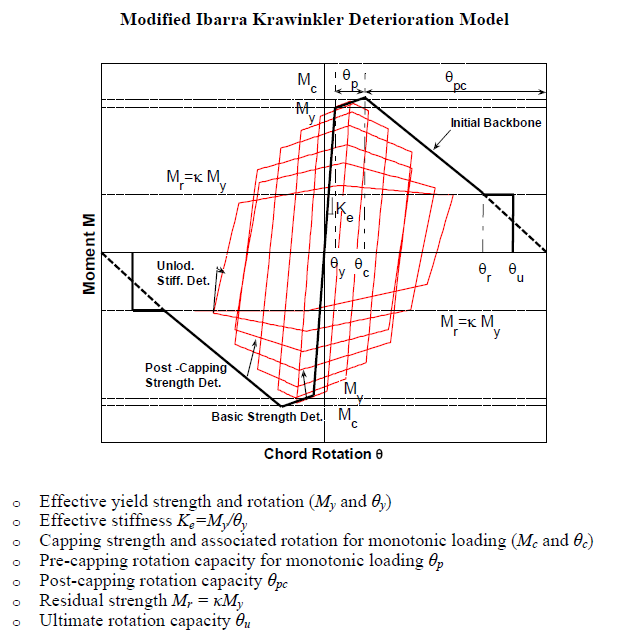Bilin Material
- Command_Manual
- Tcl Commands
- Modeling_Commands
- model
- uniaxialMaterial
- ndMaterial
- frictionModel
- section
- geometricTransf
- element
- node
- sp commands
- mp commands
- timeSeries
- pattern
- mass
- block commands
- region
- rayleigh
- Analysis Commands
- Output Commands
- Misc Commands
- DataBase Commands
This command is used to construct a bilin something or other
| uniaxialMaterial Bilin $matTag $K0 $as_Plus $as_Neg $My_Plus $My_Neg $Lamda_S $Lamda_C $Lamda_A $Lamda_K $c_S $c_C $c_A $c_K $theta_p_Plus $theta_p_Neg $theta_pc_Plus $theta_pc_Neg $Res_Pos $Res_Neg $theta_u_Plus $theta_u_Neg $D_Plus $D_Neg |
| $matTag | integer tag identifying material |
| $K0 | elastic stiffness |
| $as_Plus | strain hardening ratio for positive loading direction |
| $as_Neg | strain hardening ratio for negative loading direction |
| $My_Plus | effective yield strength for positive loading direction |
| $My_Neg | effective yield strength for negative loading direction |
| $Lamda_S | Cyclic deterioration parameter for strength deterioration |
| $Lamda_C | Cyclic deterioration parameter for post-capping strength deterioration |
| $Lamda_A | Cyclic deterioration parameter for acceleration reloading stiffness deterioration (is not a deterioration mode for a component with Bilinear hysteretic response). |
| $Lamda_K | Cyclic deterioration parameter for unloading stiffness deterioration |
| $c_S | rate of strength deterioration |
| $c_C | rate of post-capping strength deterioration |
| $c_A | rate of accelerated reloading deterioration |
| $c_K | rate of unloading stiffness deterioration |
| $theta_p_Plus | pre-capping rotation for positive loading direction (often noted as plastic rotation capacity) |
| $theta_p_Neg | pre-capping rotation for negative loading direction (often noted as plastic rotation capacity) |
| $theta_pc_Plus | post-capping rotation for positive loading direction |
| $theta_pc_Neg | post-capping rotation for negative loading direction |
| $Res_Pos | residual strength ratio for positive loading direction |
| $Res_Neg | residual strength ratio for negative loading direction |
| $theta_u_Plus | ultimate rotation capacity for positive loading direction |
| $theta_u_Neg | ultimate rotation capacity for negative loading direction |
| $D_Plus | rate of cyclic deterioration in the positive loading direction (this parameter is used to create assymetric hysteretic behavior for the case of a composite beam) |
| $D_Neg | rate of cyclic deterioration in the negative loading direction (this parameter is used to create assymetric hysteretic behavior for the case of a composite beam) |
Image from: Lignos and Krawinkler (2009, 2010a)
The deterioration model parameters can be calibrated based on actual experimental data of steel components. Instead, a user can determine the same parameters with predictive equations that have been developed by Lignos and Krawinkler (2009). These equations relate deterioration modelling parameters with geometric and material properties of steel components and have been developed with multivariate regression analysis after extensive calibration of a recently developed steel component database of more than 300 steel specimens (Lignos and Krawinkler 2007, 2009).
References:
| [1] | Ibarra L.F., and Krawinkler, H. (2005). “Global collapse of frame structures under seismic excitations”, Rep. No. TB 152, The John A. Blume Earthquake Engineering Center, Stanford University, Stanford, CA. |
| [2] | Ibarra L.F., Medina R. A., and Krawinkler H. (2005). “Hysteretic models that incorporate strength and stiffness deterioration”, Earthquake Engineering and Structural Dynamics, 34(12), 1489-1511. |
| [3] | Karavasilis T.L., Ricles J.M., Sause R. (2009). "Implementation of deterioration elements in OpenSEES for collapse simulations" ATLSS Engineering Research Center, Rep. No. 09-11. |
| [4] | Lignos, D.G., and Krawinkler, H. (2007), “A database in support of modeling of component deterioration for collapse prediction of steel frame structures”, Proc. ASCE Structures Congress, Long Beach CA, SEI institute. |
| [5] | Lignos, D.G., Krawinkler, H. (2009). “Sidesway collapse of deteriorating structural systems under seismic excitations,” Rep.No.TB 172, The John A. Blume Earthquake Engineering Research Center, Stanford University, Stanford, CA. |
| [6] | Lignos, D. G., Krawinkler, H. and Whittaker, A.S. (2010a). "Prediction and validation of sidesway collapse of two scale models of a 4-story steel moment frame", Earthquake Engineering and Structural Dynamics, EESD, (Accepted for publication, June 14th 2010). |
| [7] | Lignos, D.G., and Krawinkler, H. (2010b). “A steel database for component deterioration of tubular hollow square steel columns under varying axial load for collapse assessment of steel structures under earthquakes”, Proc. 7th International Conference on Urban Earthquake Engineering (7CUEE), March 3-5, Tokyo, Japan. |
Code Developed by : by Dr. Dimitrios G. Lignos, McGill University and was implemented by Dr. Theodore Karavasilis, Oxford University
